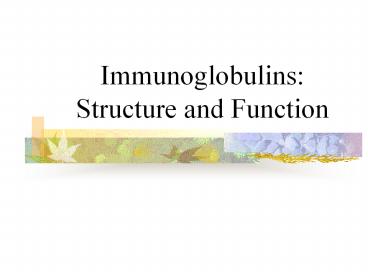Immunoglobulins: Structure and Function - PowerPoint PPT Presentation
1 / 35
Title:
Immunoglobulins: Structure and Function
Description:
Immunoglobulins: Structure and Function Immunoglobulins:Structure and Function Definition: Glycoprotein molecules that are produced by plasma cells in response to an ... – PowerPoint PPT presentation
Number of Views:326
Avg rating:3.0/5.0
Title: Immunoglobulins: Structure and Function
1
ImmunoglobulinsStructure and Function
2
ImmunoglobulinsStructure and Function
- Definition Glycoprotein molecules that are
produced by plasma cells in response to an
immunogen and which function as antibodies
3
General Functions of Immunoglobulins
- Ag binding
- Can result in protection
- Valency
- Effector functions
- Fixation of complement
- Binding to various cells
- Usually requires Ag binding
4
Basic Immunoglobulin Structure
- Immunoglobulins - heterogeneous
- Myeloma proteins - homogeneous immunoglobulins
5
Immunoglobulin Structure
- Heavy Light Chains
- Disulfide bonds
- Inter-chain
- Intra-chain
6
(No Transcript)
7
Immunoglobulins (Ig) are
glycoproteins made up of light (L) and heavy(H)
polypeptide chains. The simplest
antibody molecule has a Y shape and
consists of four polypeptide chainstwo H chains
and two L chains. The four chains are linked by
disulfide bonds.
8
Immunoglobulin Structure
- Variable Constant Regions
- VL CL
- VH CH
- Hinge Region
9
H chains are distinct for each Of
the five Ig classes or isotypes and are
designated ? a µd e for the respective
classes of Ig, namely IgG IgA IgM
IgD IgE.
10
Human Immunoglobulin Classes
- IgG - Gamma (?) heavy chains
- IgM - Mu (?) heavy chains
- IgA - Alpha (?) heavy chains
- IgD - Delta (?) heavy chains
- IgE - Epsilon (?) heavy chains
11
L chains are one of two types Designated
? and ? and only one type is found in Ig.
12
Human ImmunoglobulinLight Chain Types
- Kappa (?)
- Lambda (?)
13
L and H chains are subdivided into
variable and constant regions.The regions are
composed of three-dimensionally folded,
repeating segments called domains. An L chain
consists of one variable (VL) and one constant
(CL) domain.Most H chains consist of one
variable (VH) and three constant(CH)
domains.(IgG and IgA have three CH
domains,whereas IgM and IgE have four.)
14
Immunoglobulin Structure
- Domains
- VL CL
- VH CH1 - CH3 (or CH4)
- Oligosaccharides
15
The various regions are responsible
for antigenbinding ,whereas the constant
regions are responsible for various
biologic functions eg, complement
activation and binding to cell surface
receptors.
16
The variable regions of both L and H
chains have three extremely variable
(hypervariable) amino acid sequence at
the amino- terminal end that form the
antigen- binding site.
17
(No Transcript)
18
(No Transcript)
19
Structure of the Variable Region
- Hypervariable (HVR) or complimentarity
determining regions (CDR)
Framework regions
20
Immunoglobulin Fragments Structure/Function
Relationships
- Fab
- Ag binding
- Valence 1
- Specificty determined by VH and VL
Fc Effector functions
21
Immunoglobulin Fragments Structure/Function
Relationships
22
Immunoglobulin Fragments Structure/Function
Relationships
- Fab
- Ag binding
- Fc
- Effector functions
- F(ab)2
23
IgG
- Structure
- Monomer (7S)
24
IgG
- Structure
- Properties
- Major serum Ig
- Major Ig in extravascular spaces
- The only antibody to cross the placental
- Fixes complement
- Binds to Fc receptors
- Phagocytes - opsonization
- NK cells ADCC
- Binds to SPA
25
IgM
- Structure
- Pentamer (19S)
- composed 5 H2L2 units plus one
molecule of - J chain
- Extra domain (CH4)
- J chain
26
Fixation of C1 by IgG and IgM Abs
No activation
Activation
27
IgM
- Structure
- Properties
- 3rd highest serum Ig
- First Ig made by fetus and B cells
- Produced early in the primary response
- The most efficient Ig
- Fixes complement
Agglutinating Ig Binds to Fc receptors B cell
surface Ig
28
B Cell Antigen Receptor (BcR)
29
IgA
- Structure
- Serum - monomer
- Secretions (sIgA)
- Dimer (11S), sIgA molecule consists of two H2L2
units plus one molecule each of J chain and
secretory component(SC or SP)
30
Origin of sIgA The SP is a polypeptide
synthesized by epithelial cells that provides for
IgA passage to the mucosal surface. It also
protests IgA from being degraded in the
intestinal tract.
31
IgA
- Properties
- 2nd highest serum Ig
- Major secretory Ig ( saliva, tears, respiratory,
intestinal, and genital - tract secretions.)
- Does not fix complement unless aggregated
- Binds to Fc receptors on some cells
32
IgD
- Structure
- Monomer
- Tail piece
33
IgD
- Structure
- Properties
- 4th highest serum Ig
- B cell surface Ig
- Does not bind complement
34
IgE
- Structure
- Monomer
- Extra domain (CH4)
35
IgE
- Structure
- Properties
- Least common serum Ig
- Allergic reactions
- Parasitic infections
- Does not fix complement































